| dc.description.abstract | The balance control system ensures that humans can perform tasks in a variety of postures despite bipedal stance being inherently unstable. It manages this instability by producing motor outputs that are appropriate to sensory input given the objective of maintaining balance. An inability to maintain this balance may result in a fall which can have both short and long-term physical, psychological, and social effects. The ability to maintain balance is a strong predictor of fall-risk and mobility limitations. Falling has been associated with specific populations such as older adults and those with neurological and neuromuscular pathologies. However, it is possible that some younger individuals may have poor balance control which places them at a greater fall-risk in the face of age and pathology-related influences. The potential importance of revealing person-specific differences in balance control in healthy, young adults has led to the focus of this thesis. This thesis was designed to determine whether a healthy, young adult’s balance control system, as measured by their balance performance, is specific to the individual and could be distinguished from any other individual. The thesis explores the use of different methods of measuring of body movement (kinetic or kinematic), and the analytical techniques which, when collectively applied, may more sensitively reveal these individual differences.
General methodology consisted of sixty-one healthy, young adults (ages 18-35), free of any neurological or neuromuscular disorders, performing a series of static standing balance trials. Four task conditions, Base of Support (standard and narrow) and Vision (open and closed), were performed five times, each for thirty seconds. Balance performance was measured kinetically using two floor-mounted force plates, and kinematically using three inertial measurement units placed on the head, sternum, and lumbar region of the back. The resulting data became the substrate for the analyses used in the three studies. Study 1 quantified the consistency of an individual’s balance performance across task conditions relative to the other individuals. Centre-of-pressure data collected from force plates was analyzed using established linear and non-linear analytical methods within the
time- and frequency-domains and then input into a linear mixed-effects model. Subject-specific factors, such as anthropometrics and vision quality, were controlled to reduce the number of confounding variables. Correlational analysis of the random-effect, participant, revealed moderate to strong correlations of individual balance performances across task conditions with the strength of these correlations dependent on the analytical technique used. Study 1 confirmed that (1) task-related differences in balance performance could be detected by a variety of analytical techniques, and that (2) the correlations found in relative balance performance across task conditions suggest that an individuals’ balance control system may be specific to the individual.
Study 2 expanded on Study 1 by representing body movement kinematically using body-worn inertial measurement units. Similar analytical approaches were used and moderate to excellent correlations in relative balance performance across task conditions were observed. The use of kinematic data in this study also revealed kinematic strategies that could only be obtained by modelling a person as a multi-link, rigid body and not as a single-link, inverted pendulum; an assumption commonly made when using kinetic data. Like Study 1, this work demonstrated that relative balance performance within persons were comparable across tasks of varying difficulty and, as such, indirectly supports the idea that balance control that may be specific to the individual.
Study 3 focused on analytical approaches that could more directly reveal the unique features of balance control within individuals. This study employed a machine-learning, classification algorithm in an attempt to identify individuals by their balance performance using kinetic or kinematic measures. Once provided with the prototypical balance performances of a discrete number of individuals, the algorithm was able to correctly attribute the balance performance of a mystery person to one of those individuals with an accuracy greater that what could be achieved by random chance. Representing body movement with kinetic, time-series data yielded the highest accuracies (Accuracy (nway = 5) = 92.08%; Accuracy (nway = 20) = 74.69%). However, it is believed that if kinematic data was recorded with more fidelity, then even greater accuracies could be possible. Study 3 demonstrated that (1) balance performance data contains features specific to the individual which may quantitatively indicate individuality in the balance control system, and (2) that the ability to reveal this individuality is dependent on how the balance performance is represented.
This thesis provided two main contributions, (1) support for the idea that balance control during quiet standing, as revealed through balance performance, contains features that are specific to the individual, and (2) an, outline, albeit preliminary, of the task conditions, methods of measurement, and analytical techniques best suited to reveal this individuality. | en |

